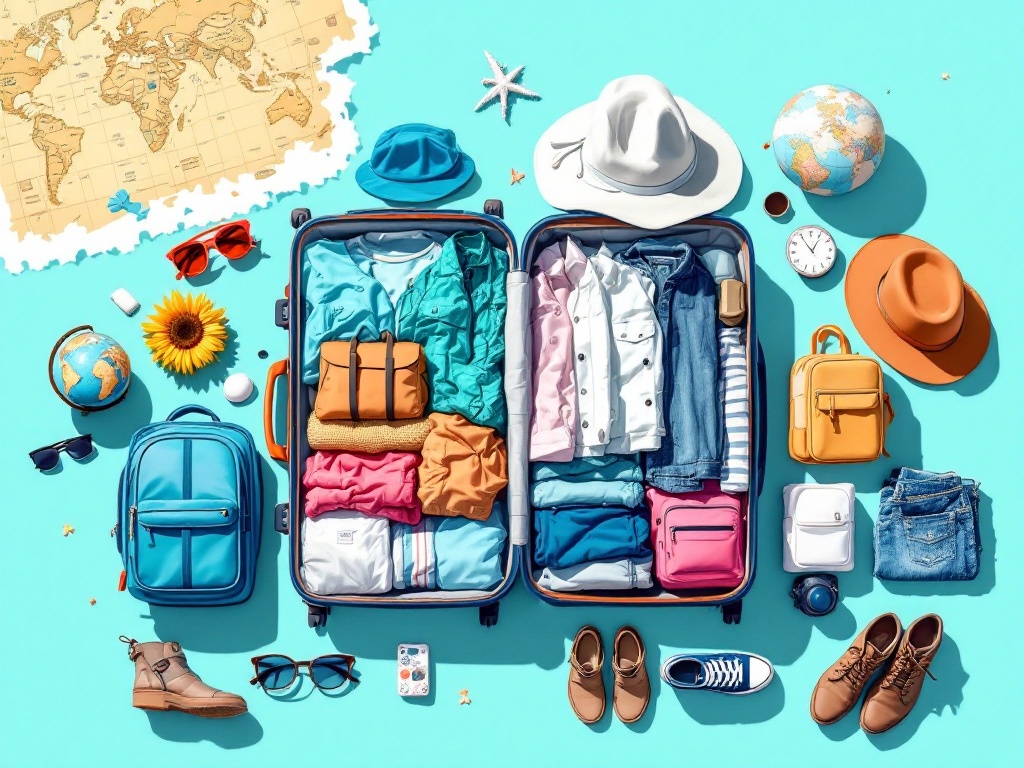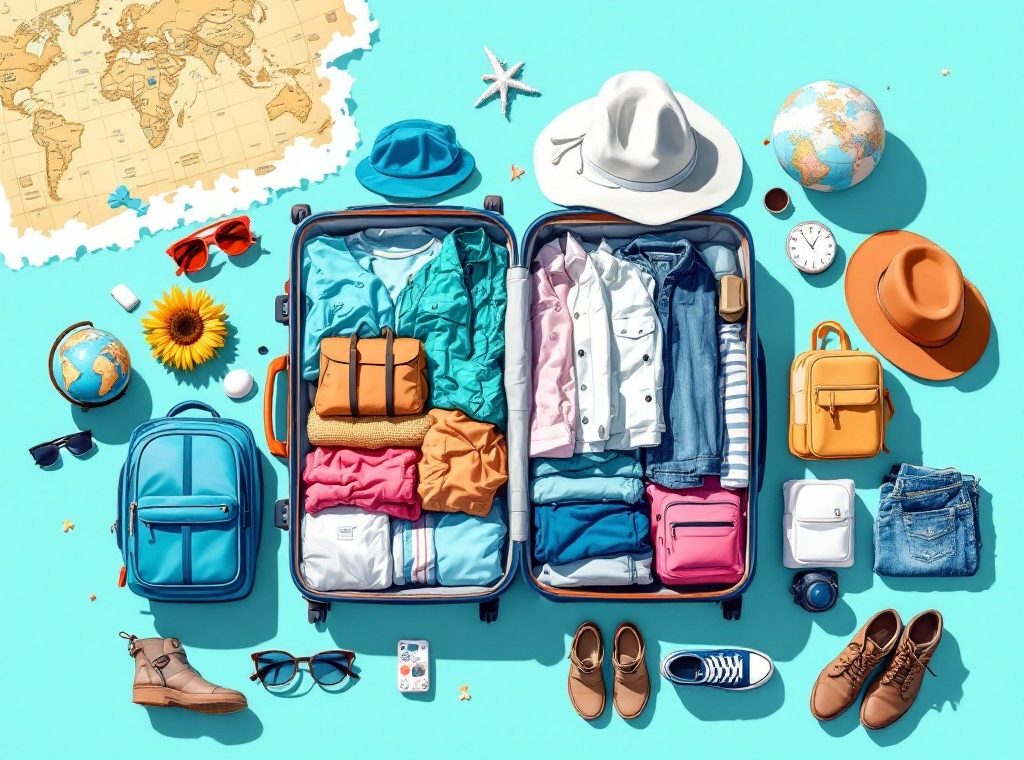What to Pack for Different Climates: A Comprehensive Guide
Dream of traveling light without sacrificing style? Mastering the art of packing for diverse climates is key. This guide unlocks packing strategies for hot, cold, and rainy weather, from versatile capsule wardrobes to layering essentials. Discover how to select breathable fabrics, utilize packing cubes, and choose the right footwear. Prepare for any adventure with our expert advice and pack like a pro!
Important information

- Research the climate of your destination and length of your stay to pack efficiently. Consider your planned activities.
- Pack versatile, neutral-colored clothing items in layers for unpredictable weather changes. Quick-drying fabrics are best.
- For cold climates, prioritize thermal base layers, insulating mid-layers (fleece or wool), and a waterproof outer shell. Don’t forget warm accessories.
- For warm climates, pack lightweight, breathable clothing (cotton, linen), sun protection (hat, sunglasses, sunscreen), and comfortable sandals. A light jacket is useful for cooler evenings.
- For rainy weather, pack a waterproof and windproof jacket, an umbrella, waterproof shoes, and quick-drying clothes. A waterproof bag protects electronics.
Understanding Climate Zones and Packing Needs
Research your destination’s climate and the length of your stay to pack efficiently.
Consider your planned activities to determine the appropriate clothing and gear.
Pack layers and versatile neutral-colored items for unpredictable weather.
Quick-drying fabrics are also recommended.
A travel-sized first-aid kit is a good idea, but check airline regulations for restrictions.
Identifying Your Travel Destinations
Before starting your trip, check the weather forecast and research local activities. Pack adaptable clothing, especially if you plan to visit multiple destinations. Think about your travel budget and the ease of transportation in your chosen area.
Weather Variables and Their Impact on Packing
Prepare for fluctuating temperatures by packing layers, such as sweaters, jackets, and long-sleeved shirts.
If rain or snow is anticipated, waterproof outerwear is crucial. Be sure to pack waterproof jackets, pants, and shoes.
Consulting the weather forecast will guide your clothing choices.
Pack breathable fabrics for hot, humid climates, while thermal layers are essential for colder destinations.
Packing Strategies for Multiple Climates
Traveling light to various climates requires preparation. Start by checking the weather forecast for your destinations to pack appropriate clothing. A packing list, categorized by hot, cold, and rainy conditions, can be invaluable. Prioritize versatile, neutral-colored clothing for easy mixing and matching.Layering is crucial for fluctuating temperatures. Begin with breathable base layers. Add insulating mid-layers like sweaters or fleece. Complete your outfit with a waterproof outer shell. This adaptable system ensures comfort in any climate.Consider clothing with multiple functions. Convertible pants that transform into shorts and neutral tops and bottoms maximize outfit combinations while minimizing packed items. This strategy allows you to travel lighter and more efficiently.
Planning Ahead: Key to a Well-Packed Bag
Before embarking on your journey, check the weather forecast. Packing appropriate clothing ensures you’re prepared for any weather conditions, preventing unnecessary baggage. This allows you to have the right outfit for any occasion.
Layering: Your Golden Ticket for Packing Light
Layering your clothes is a smart way to deal with fluctuating temperatures, especially when packing light. By simply adding or removing items like a t-shirt, sweater, and jacket, you can easily adjust to changing conditions. This adaptable approach is incredibly efficient and allows you to be prepared for anything.
Mixing and Matching: Creating Outfits with Fewer Pieces
Traveling light? A capsule wardrobe is your best friend. Select versatile items that can be mixed and matched. A coordinated color palette expands outfit options. Neutrals—black, white, and gray—offer endless flexibility, pairing seamlessly with pops of color. A simple white shirt, for instance, can be worn with jeans, a skirt, or layered under a sweater. Efficient packing is equally crucial. Packing cubes are a game-changer, minimizing wrinkles and maximizing space. Another space-saving tip? Roll your clothes instead of folding them.
Benefits of a Capsule Wardrobe
- Creates versatile outfits with fewer items.
- Simplifies packing and reduces luggage weight.
- Saves money by focusing on quality over quantity.
Efficient Packing Tips
- Use packing cubes to organize and compress clothing.
- Roll clothes instead of folding to save space and minimize wrinkles.
- Choose lightweight, quick-drying fabrics.
The Essential Packing List for Different Climates
Packing for a Warm Climate
When preparing for a trip to a warmer climate, prioritize lightweight clothing such as shorts, t-shirts, and sundresses. Sun protection is essential, so pack a wide-brimmed hat, sunglasses, and sunscreen with a high SPF. Comfortable footwear like sandals or flip-flops are also recommended. Staying hydrated is vital in warm climates, so bring a reusable water bottle to refill throughout the day. Evenings can be surprisingly cool, so packing a light jacket is a smart precaution.
Packing for a Cold Destination
Layering is key for cold destinations. Start with thermal base layers for warmth, add a fleece or wool sweater for insulation, and finish with a waterproof, windproof outer layer. Don’t forget essential accessories like a warm hat, gloves, and a scarf. Protecting your feet from the cold with insulated boots and thick socks is crucial. Pack hand and foot warmers for extra warmth in extreme cold.
Packing for Rainy Weather
If rain is in the forecast, pack accordingly. A waterproof, windproof jacket is a must-have, and an umbrella offers additional protection. Waterproof shoes or boots will keep your feet dry and comfortable. Quick-drying clothing is essential for rainy conditions. A waterproof bag will safeguard your electronics and other important items from the elements. Consider packing a small, quick-drying towel for added convenience.
Hot Weather Essentials
Dress in cool, comfortable clothes.
Choose breathable fabrics like cotton and linen, and opt for sundresses, shorts, and tank tops.
Protect yourself from the sun.
Remember a wide-brimmed hat, sunglasses, and sunscreen to shield your skin from harmful UV rays.
Stay hydrated.
Carry a refillable water bottle and sip regularly.
Choose breathable footwear.
Opt for flip-flops or sandals.
Pack a light jacket.
Evenings can get cooler.
Cold Weather Essentials
Start with a thermal base layer to trap warm air against your skin.
Add a warm mid-layer like a fleece or wool sweater.
Put on a waterproof, windproof outer layer such as a down jacket or parka.
Accessorize with a hat, gloves, and a scarf to keep your extremities warm.
Wear thick socks and insulated, waterproof boots for warm, dry feet.
Rainy Weather Essentials
Pack a packable rain jacket, essential for unpredictable weather.
Supplement with other water-resistant outerwear for added protection.
For downpours, an umbrella or poncho offers superior defense.
Choose quick-drying fabrics and layers to enhance comfort.
Safeguard electronics and valuables in a waterproof bag.
If you anticipate mud, sturdy boots are recommended.
Packing Tips for Specific Climate Zones
Tropical Climate
When packing for a tropical climate, prioritize light, breathable clothing. Consider packing items such as cotton shirts, shorts, and dresses. Don’t forget essentials like a swimsuit, sunscreen, insect repellent, and a hat. Sandals are ideal footwear, and a light rain jacket is advisable.
Dry Climate
Breathable attire is also recommended for dry climates. Long-sleeved shirts and loose pants are ideal for sun protection. Remember a wide-brimmed hat, sunglasses, and sunscreen. Layering is important for cooler evenings. Sturdy shoes will aid exploration, and a reusable water bottle is essential for staying hydrated.
Temperate Climate
Temperate climates require adaptable layering. Pack sweaters, long-sleeved shirts, and a medium-weight jacket. Include both short and long-sleeved options for versatility. Don’t forget an umbrella or waterproof jacket for unexpected showers, and comfortable walking shoes are a must.
Continental Climate
Continental climates demand preparation for temperature fluctuations. Layering is key, so pack sweaters, jackets, and long pants. Choose versatile, comfortable shoes suitable for various activities.
Polar Climate
Polar expeditions necessitate specialized gear. Thermal base layers are essential for warmth, along with insulated jackets and waterproof outer layers. Protect extremities with hats, gloves, scarves, and thermal socks. Sturdy, waterproof boots are vital for navigating icy terrain.
Tropical Climate: What to Pack
Pack for your trip with light, breathable clothing such as cotton shirts, linen shorts, sundresses, or swimwear. For sun protection, bring a wide-brimmed hat, sunglasses, and sunscreen. Comfortable sandals are essential, and a light rain jacket is recommended. Remember a reusable water bottle for hydration and insect repellent.
Dry Climate: Essential Items
In dry climates, opt for light, breathable clothing to stay cool.
A hydration pack is essential for handling the arid conditions.
Don’t forget a wide-brimmed hat and sunglasses for sun protection.
Temperate Climate: Packing Suggestions
To prepare for fluctuating weather conditions, pack your clothing in layers. This might include t-shirts, long-sleeved shirts, light sweaters, and a medium-weight jacket. Comfortable walking shoes are crucial. Pack an umbrella or waterproof jacket for unexpected showers.
Continental Climate: Key Clothing Items
Pack clothes that can be easily adjusted for changes in temperature. Layering is key: think t-shirts, long-sleeved shirts, light sweaters, and a jacket. This adaptable approach ensures comfort whatever the weather. For footwear, pack comfortable walking shoes suitable for varied terrains. A pair of sandals can be useful for warmer days or evenings. Don’t forget essential accessories like a hat, sunglasses, and sunscreen to protect yourself from the sun. A small, foldable umbrella can be a lifesaver in unexpected showers.
Polar Climate: Must-Have Gear
Start with thermal underwear as your base layer.
Add mid-layers such as fleece for extra insulation.
Wear a well-insulated jacket, crucial for trapping heat.
Use waterproof and windproof outer layers for protection against the elements.
Wear thick socks and insulated boots for warm feet.
Protect your hands with gloves or mittens.
Use a hat and scarf for additional protection, and a balaclava for full face and neck coverage.
Wear snow goggles to shield your eyes from glare and wind.
Carry a safety kit containing a first-aid kit, whistle, and flashlight for unforeseen situations.
Choosing the Right Clothing and Accessories
Packing for a trip requires careful consideration of the climate. For warm destinations, pack light and breathable fabrics like cotton and linen to stay cool. If traveling to a cold climate, thermal layers such as wool or fleece are essential for warmth. Regardless of the temperature, pack water-resistant outerwear, including a raincoat and waterproof boots, to prepare for unexpected rain. Your footwear should be versatile and suited to your planned activities. Hiking boots are ideal for trails, while comfortable walking shoes are better for city exploration. Choosing appropriate shoes ensures both comfort and practicality.
Packing for Warm Climates
- Choose light, breathable fabrics like cotton and linen, to stay cool and comfortable.
Packing for Cold Climates
- Pack thermal layers such as wool or fleece to maintain warmth.
Regardless of the climate, always pack water-resistant outerwear, including a raincoat and waterproof boots, to be prepared for unexpected rain.
Footwear for Hiking
- Hiking boots are ideal for trails and provide ankle support and traction.
Footwear for City Exploration
- Comfortable walking shoes are better for city exploration and sightseeing.
Choosing appropriate shoes ensures both comfort and practicality during your travels.
Lightweight and Breathable Fabrics
Pack light, breathable fabrics like linen, cotton, silk, and merino wool for your next trip. These natural materials offer exceptional comfort in warm climates and can be easily layered for cooler destinations. A key advantage is their quick-drying nature, which is great for travelers who might need to hand-wash a shirt one evening and wear it the next morning. Beyond practicality, these fabrics often appear more refined than synthetics, allowing you to travel comfortably and stylishly.
Thermal Layers for Cold Climates
Staying warm in cold weather involves a strategic layered approach. Start with a thermal base layer to effectively trap your body heat. Add an insulating mid-layer, such as fleece or wool, for extra warmth. Finally, a waterproof and windproof outer shell provides a crucial barrier against the elements. Essential accessories, like gloves, a hat, and a scarf, further enhance warmth, while insulated boots and thick socks ensure warm, dry feet.
Start with a thermal base layer to effectively trap your body heat.
Add an insulating mid-layer, such as fleece or wool, for extra warmth.
Use a waterproof and windproof outer shell to provide a crucial barrier against the elements.
Wear essential accessories, like gloves, a hat, and a scarf, to further enhance warmth.
Ensure warm, dry feet with insulated boots and thick socks.
Water-Resistant Outerwear for Rainy Days
When the skies turn gray, equip yourself with dependable water-resistant outerwear, such as a raincoat or waterproof jacket. Prioritize breathable fabrics like Gore-Tex or nylon for superior protection. Look for features like taped seams and an adjustable hood for extra defense against downpours. A longer coat provides more coverage, while a shorter style offers greater mobility. Choose the length that aligns with your lifestyle and activities.
Versatile Footwear for All Weather Conditions
When packing shoes, versatility is key. Consider packing waterproof ankle boots for various weather conditions. Comfortable sneakers are another practical option.
Avoiding Overpacking: Tips for Keeping Luggage Light
A capsule wardrobe involves curating a small collection of essential clothing in neutral colors. This minimalist approach allows for versatile mix-and-match outfits, maximizing options while minimizing the number of items. It’s a great way to declutter and simplify your closet.
Another travel tip is to wear your bulkiest items, like jackets and boots, rather than packing them. This simple strategy saves valuable luggage space and makes traveling easier.
Choosing a Capsule Wardrobe
Pack light, dress sharp: that’s the magic of a capsule wardrobe. Built on a foundation of versatile, coordinating pieces, you can mix and match them to create countless outfits. This not only simplifies packing but also lightens your luggage. For instance, select neutral bottoms and tops, then add a splash of color with accessories like a scarf or cardigan. This strategy unlocks numerous outfit combinations. The secret lies in choosing durable, high-quality items. Also, factor in your destination’s climate when building your capsule wardrobe to ensure you’re ready for anything.
Benefits of a Capsule Wardrobe
- Simplified packing.
- Lighter luggage.
- Numerous outfit combinations.
Tips for Creating a Capsule Wardrobe
- Choose versatile, coordinating pieces.
- Select neutral bottoms and tops.
- Add pops of color with accessories.
- Prioritize durable, high-quality items.
- Consider your destination’s climate.
Wearing Bulky Layers During Travel
Wear bulky items like jackets and boots to save valuable luggage space. This allows you to pack more essential items.


















